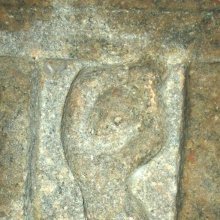Abadha, Ābādha, Ābadha, Abādha, Abadhā: 20 definitions
Introduction:
Abadha means something in Buddhism, Pali, Hinduism, Sanskrit, the history of ancient India, Marathi, Hindi. If you want to know the exact meaning, history, etymology or English translation of this term then check out the descriptions on this page. Add your comment or reference to a book if you want to contribute to this summary article.
Images (photo gallery)
In Hinduism
Vyakarana (Sanskrit grammar)
Source: Wikisource: A dictionary of Sanskrit grammar1) Abādha (अबाध).—Similarity of one phonetic element, for instance, in the case of ऐ (ai) with आ (ā) resulting from Saṃdhi: e. g. प्रजाया अरातिं निर्ऋत्या अकः (prajāyā arātiṃ nirṛtyā akaḥ) where प्रजाया (prajāyā) and निर्ऋत्या (nirṛtyā) stand for प्रजायै (prajāyai) and निर्ऋत्यै (nirṛtyai) cf. एकारान्तानि आकारबाधे (ekārāntāni ākārabādhe) Āth. Pr. II.1.4;
2) Abādha.—Similarity of accent of words in the Saṃhitāpāṭha and Padapāṭha;
3) Abādha.—Followed by cf. A. Pr. II.1.14;
4) Abādha.—Distress; cf. आबाधे च (ābādhe ca), P. VIII.1.10.

Vyakarana (व्याकरण, vyākaraṇa) refers to Sanskrit grammar and represents one of the six additional sciences (vedanga) to be studied along with the Vedas. Vyakarana concerns itself with the rules of Sanskrit grammar and linguistic analysis in order to establish the correct context of words and sentences.
Jyotisha (astronomy and astrology)
Source: Wikibooks (hi): Sanskrit Technical TermsĀbādhā (आबाधा).—(or avabādhā, avadhā, abadhā, badhā) Segment of the base of triangle produced by the altitude on it; the projection of any slanting side on the horizontal. Note: Ābādhā is a Sanskrit technical term used in ancient Indian sciences such as Astronomy, Mathematics and Geometry.

Jyotisha (ज्योतिष, jyotiṣa or jyotish) refers to ‘astronomy’ or “Vedic astrology” and represents the fifth of the six Vedangas (additional sciences to be studied along with the Vedas). Jyotisha concerns itself with the study and prediction of the movements of celestial bodies, in order to calculate the auspicious time for rituals and ceremonies.
In Buddhism
Theravada (major branch of Buddhism)
Source: Dhamma Dana: Pali English GlossaryM The fact to be free from all hindrances, all interdictions.
Theravāda is a major branch of Buddhism having the the Pali canon (tipitaka) as their canonical literature, which includes the vinaya-pitaka (monastic rules), the sutta-pitaka (Buddhist sermons) and the abhidhamma-pitaka (philosophy and psychology).
India history and geography
Source: Cologne Digital Sanskrit Dictionaries: Indian Epigraphical GlossaryĀbādha.—(CII 1), illness. Note: ābādha is defined in the “Indian epigraphical glossary” as it can be found on ancient inscriptions commonly written in Sanskrit, Prakrit or Dravidian languages.
--- OR ---
Ābādhā.—(EI 15), same as bādhā or vādhā; obstacle. Note: ābādhā is defined in the “Indian epigraphical glossary” as it can be found on ancient inscriptions commonly written in Sanskrit, Prakrit or Dravidian languages.

The history of India traces the identification of countries, villages, towns and other regions of India, as well as mythology, zoology, royal dynasties, rulers, tribes, local festivities and traditions and regional languages. Ancient India enjoyed religious freedom and encourages the path of Dharma, a concept common to Buddhism, Hinduism, and Jainism.
Languages of India and abroad
Pali-English dictionary
Source: BuddhaSasana: Concise Pali-English Dictionaryabādha : (adj.) without any hindrance. || ābādha (m.) disease; affliction.
Source: Sutta: The Pali Text Society's Pali-English DictionaryĀbādha, (ā + bādh to oppress, Vedic ābādha oppression) affliction, illness, disease Vin.IV, 261; D.I, 72; II, 13; A.I, 121; III, 94, 143; IV, 333, 415 sq., 440; Dh.138; Pug.28; Vism.41 (udara-vāta°) 95; VvA.351 (an° safe & sound); SnA 476; Sdhp.85. — A list of ābādhas or illnesses, as classified on grounds of aetiology, runs as follows: pittasamuṭṭhānā, semha°, vāta°, sannipātikā, utu-pariṇāmajā, visama-parihārajā, opakkamikā, kammavipākajā (after Nd2 304I.C., recurring with slight variations at S.IV, 230; A.II, 87; III, 131; V, 110; Nd1 17, 47; Miln.112, cp. 135). ‹-› Another list of illnesses mentioned in tha Vinaya is given in Index to Vin.II, , p. 351. — Five ābādhas at Vin.I, 71, viz. kuṭṭhaṃ gaṇḍo kilāso soso apamāro said to be raging in Magadha cp. p. 93. — Three ābādhas at D.III, 75, viz. icchā anasanaṃ jarā, cp. Sn.311. — See also cpd. appābādha (health) under appa. (Page 103)

Pali is the language of the Tipiṭaka, which is the sacred canon of Theravāda Buddhism and contains much of the Buddha’s speech. Closeley related to Sanskrit, both languages are used interchangeably between religions.
Marathi-English dictionary
Source: DDSA: The Molesworth Marathi and English Dictionaryabādha (अबाध).—a S abādhita a (S) Unblamed, unobjected to, unexcepted against, unopposed. 2 Laxly. Thatcannot be opposed, withstood, resisted, denied, gainsaid. Ex. abādhitabuddhi-kalpanā-parākrama-sāmarthya- cāturya-kauśalya &c.
--- OR ---
ābādhā (आबाधा).—f S A segment of the base of a triangle; esp. that formed by the perpendicular falling from the vertex.
Source: DDSA: The Aryabhusan school dictionary, Marathi-Englishabādha (अबाध).—a Unobjected to, unex- cepted against, unopposed. That cannot be opposed, resisted or gain- said, as abādhitaparākrama.
Marathi is an Indo-European language having over 70 million native speakers people in (predominantly) Maharashtra India. Marathi, like many other Indo-Aryan languages, evolved from early forms of Prakrit, which itself is a subset of Sanskrit, one of the most ancient languages of the world.
Sanskrit dictionary
Source: DDSA: The practical Sanskrit-English dictionaryAbadha (अबध).—See अवध-ध्य (avadha-dhya) &c.
See also (synonyms): abadhya.
--- OR ---
Abadhā (अबधा).—f. Segment of the basis of a triangle. See अबाधा (abādhā)
--- OR ---
Abādha (अबाध).—a. Unrestrained, unobstructed.
2) Free from pain.
-dhā The segment of the base of a triangle.
-dhaḥ 1 Non-obstruction.
2) Non-refutation.
--- OR ---
Ābadha (आबध).—Ved. Binding.
Derivable forms: ābadhaḥ (आबधः).
--- OR ---
Ābādha (आबाध).—1 Affliction, injury, trouble, molestation, damage; न प्राणाबाधमाचरेत् (na prāṇābādhamācaret) Manusmṛti 4.54,51.
2) Interruption, hinderance; दर्शनीयं निराबाधं कुम्भकर्णस्य चक्रिरे (darśanīyaṃ nirābādhaṃ kumbhakarṇasya cakrire) Rām.7.13.4.
3) Attack (Ved).
-dhā 1 Pain, distress.
2) Mental agony or anguish.
3) Segment of the base of a triangle.
Derivable forms: ābādhaḥ (आबाधः).
Source: Cologne Digital Sanskrit Dictionaries: Shabda-Sagara Sanskrit-English DictionaryAbadha (अबध).—m.
(-dhaḥ) Not killing. f.
(-dhā) The segment of the base of a triangle. E. a neg. badha what kills.
--- OR ---
Abādha (अबाध).—mfn.
(-dhaḥ-dhā-dhaṃ) 1. Unobstructed, unrestrained. 2. Free from pain. f.
(-dhā) 1. Segment of the base of a triangle. 2. Indistinctness, perplexity. E. a neg. and bādha to oppose, ac aff.
--- OR ---
Ābādhā (आबाधा).—f.
(-dhā) Segment of the base of a triangle.
Source: Cologne Digital Sanskrit Dictionaries: Benfey Sanskrit-English DictionaryĀbādha (आबाध).—[ā-bādh + a], m. Injury, [Mānavadharmaśāstra] 4, 51.
Source: Cologne Digital Sanskrit Dictionaries: Cappeller Sanskrit-English DictionaryAbādha (अबाध).—[adjective] unimpeded.
--- OR ---
Ābādha (आबाध).—[masculine] attack; trouble, pain, sorrow (also [feminine] ā).
Source: Cologne Digital Sanskrit Dictionaries: Monier-Williams Sanskrit-English Dictionary1) Abadha (अबध):—[=a-badha] See a-vadha.
2) Abadhā (अबधा):—f. segment of the basis of a triangle (cf. a-bādhā and avabadhā. In Jaina Prākṛt abahā, or avahā.)
3) a segment of the basis of a triangle, [Līlāvatī of bhāskara]
4) Abādha (अबाध):—[=a-bādha] mfn. unobstructed, unrestrained
5) [v.s. ...] free from pain
6) Abādhā (अबाधा):—[=a-bādhā] [from a-bādha] f. freedom from pain, [Mārkaṇḍeya-purāṇa]
7) [v.s. ...] = a-badhā q.v.
8) Ābādha (आबाध):—[=ā-bādha] [from ā-bādh] m. pressing towards, [Ṛg-veda viii, 23, 3]
9) [v.s. ...] molestation, trouble
10) [v.s. ...] m. and (ā), f. pain, distress, [Mahābhārata; Manu-smṛti; Suśruta; Kirātārjunīya] etc.
11) Ābādhā (आबाधा):—[=ā-bādhā] [from ā-bādha > ā-bādh] f. (in [mathematics]) segment of the base of a triangle
12) Ābādha (आबाध):—[=ā-bādha] [from ā-bādh] mfn. distressed, tormented, [Tārānātha tarkavācaspati’s Vācaspatyam, Sanskrit dictionary]
Source: Cologne Digital Sanskrit Dictionaries: Goldstücker Sanskrit-English DictionaryAbādha (अबाध):—I. [tatpurusha compound] m.
(-dhaḥ) 1) Non-obstruction.
2) Non-refu-tation, the not being contradicted by or incompatible with; e. g. in the Sāṅkhya Sūtras: abādhādaduṣṭakāraṇajanyatvācca nāvastutvam (scil. prapañcasya); or abādhe (scil. avidyāyā vidyayā) naiṣphalyam (scil. vidyāyāḥ); or in the Vedānta S.: abādhācca (Anūpanār.: śaktau sadācaraṇe jñānabādhābhāvācca); comp. s. v. abādhita. E. a neg. and bādha. Ii. [bahuvrihi compound] m. f. n.
(-dhaḥ-dhā-dham) Unimpeded, unobstructed; e. g. in the Nalop.: vītaśoka bhayābādhaṃ kaccittvaṃ dṛṣṭavānnṛpam (i. e. free from fear). E. a priv. and bādha.
Source: Cologne Digital Sanskrit Dictionaries: Yates Sanskrit-English Dictionary1) Abādha (अबाध):—[a-bādha] (dhaḥ-dhā-dhaṃ) a. Unobstructed. f. A segment; indistinctness.
2) Ābādhā (आबाधा):—[ā-bādhā] (dhā) 1. f. Segment of the base of a triangle.
Source: DDSA: Paia-sadda-mahannavo; a comprehensive Prakrit Hindi dictionary (S)Abādhā (अबाधा) in the Sanskrit language is related to the Prakrit words: Abāhā, Ābāhā, Āvāha.
[Sanskrit to German]
Sanskrit, also spelled संस्कृतम् (saṃskṛtam), is an ancient language of India commonly seen as the grandmother of the Indo-European language family (even English!). Closely allied with Prakrit and Pali, Sanskrit is more exhaustive in both grammar and terms and has the most extensive collection of literature in the world, greatly surpassing its sister-languages Greek and Latin.
Hindi dictionary
Source: DDSA: A practical Hindi-English dictionaryAbādha (अबाध) [Also spelled abadh]:—(a) without restraint; free, smooth; —[gati] unrestrained movement, smooth pace; hence ~[tā] (nf).
...
Kannada-English dictionary
Source: Alar: Kannada-English corpusAbādha (ಅಬಾಧ):—[adjective] being free from annoyance, trouble, hindrance or obstruction.
Kannada is a Dravidian language (as opposed to the Indo-European language family) mainly spoken in the southwestern region of India.
See also (Relevant definitions)
Starts with: Abadha-vyapara, Abadhaka, Abadhakanem, Abadhakavrata, Abadharha, Abadhavistara.
Ends with (+28): Alpabadha, Anabadha, Anagatabadha, Anupabadha, Apabadha, Appabadha, Attavyabadha, Avabadha, Avyabadha, Badhabadha, Bavhabadha, Bhayabadha, Bhramarabadha, Bhutabadha, Brahmanabadha, Byabadha, Chavidosabadha, Dandabadha, Devatabadha, Durabadha.
Full-text (+25): Anabadha, Abadhaka, Avabadha, Abaha, Durabadha, Abadhya, Anagatabadha, Nirabadha, Nirabadhakara, Sisabadha, Vatabadha, Nirabadham, Abadhika, Avaha, Chavidosabadha, Abadheti, Vyabadha, Patipanameti, Rituparinamika, Kayacitta.
Relevant text
Search found 11 books and stories containing Abadha, Ābādha, Ābadha, Abādha, Abadhā, Ābādhā, A-badha, A-bādha, Abādhā, A-bādhā, Ā-bādha, Ā-bādhā; (plurals include: Abadhas, Ābādhas, Ābadhas, Abādhas, Abadhās, Ābādhās, badhas, bādhas, Abādhās, bādhās). You can also click to the full overview containing English textual excerpts. Below are direct links for the most relevant articles:
Rig Veda (translation and commentary) (by H. H. Wilson)
Rig Veda 8.23.3 < [Sukta 23]
Bhagavati-sutra (Viyaha-pannatti) (by K. C. Lalwani)
Part 4 - Karma and its span < [Chapter 3]
Part 3 - Harinaigameṣī (the order-bearer of Śakra) < [Chapter 4]
The Tattvasangraha [with commentary] (by Ganganatha Jha)
Verse 586 < [Chapter 10 - The Examination of the First Category—‘Substance’]
Dhammapada (Illustrated) (by Ven. Weagoda Sarada Maha Thero)
Verse 137-140 - The Story of Venerable Mahā Moggallāna < [Chapter 10 - Daṇḍa Vagga (Punishment)]
Bhesajjakkhandhaka (Chapter on Medicine) (by Hin-tak Sik)
Medical Principles (In Early Buddhist Scriptures) < [Chapter 3 - Concepts of Health and Disease]
Concepts of Health and Disease (In early Buddhism) < [Chapter 3 - Concepts of Health and Disease]
Maha Prajnaparamita Sastra (by Gelongma Karma Migme Chödrön)
II. Attributes to be fulfilled (prāptukāma) and attributes to be cognized (jñātukāma) < [Part 1 - General questions]
A. Sattvaśūnyatā or Pudgalanairātmya < [I. The twofold emptiness in the canonical sūtras]

